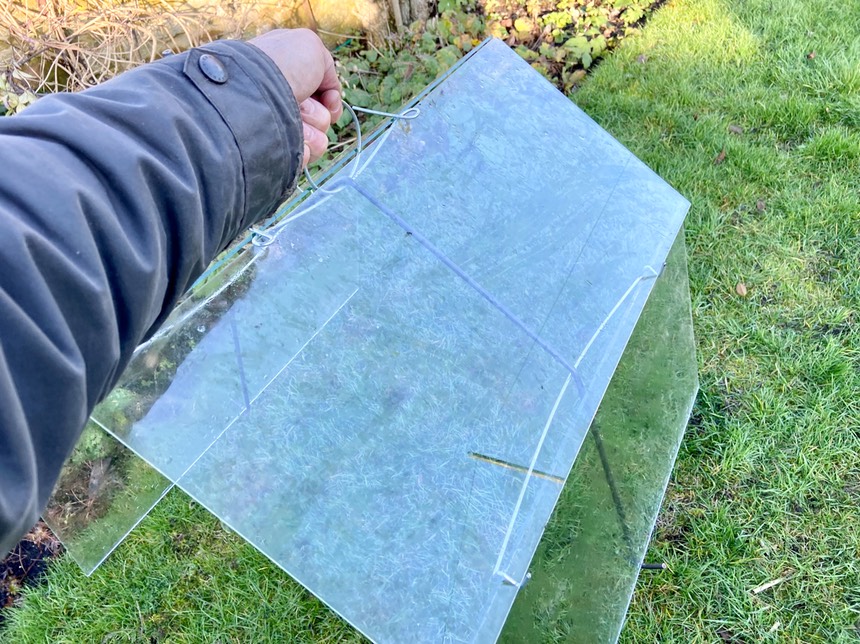The advantages of using a cloche or a row of continous cloches are:
1. They warm up the soil early in the season and produce an earlier crop. Also, cropping later in the year is possible with the chance of two crops a year.
2. The plants, especially young plants, are protected from harsh weather and also animal damage such as rabbits, pigeons and cats. Fuller protection is provided by adding end closure panes to prevent access. This is done using two standard panes of the same size as the glazing panes. They are held against the cloche end by a bamboo cane and wired to the nearest cloche ridge handle.
3. Rain water and irrigation water falls off the cloche roof and sides and soaks into the ground around the cloche. However, the soil surface inside the cloche tend to remain dry and contrary to thinking, this has the very great advantage of helping prevent fungal disease in young plants. There should be no need to water inside the cloche. By allowing the rain and irrigation waters to surround the soil around the cloche, enough will migrate to the roots of the plants within the cloche and also those roots will ‘reach out’ towards the wetter soil aound the cloche making for much stronger plants with better yields.
4. Each High Barn cloche is nominally 610mm long by 630mm wide and 480mm high to the apex. (24” x 25” x 19” tall). This means many full sized vegetables, fruiting plants and salad crops can be accomadated within the cloche such as low Tomato bushes, melons, squash, dwarf beans, strawberries etc. Straw can be laid on the ground inside the cloches to protect fruits. Early potatoes and carrots can be raised until the cloches are no longer needed and they can be moved to protect other crops or successional planting. The same with sweetcorn. Rhubarb covered with a cloche will produce an early crop somewhere between forced and open ground grown. If that’s not enough, cut flowers do very well under cloches. The assembled cloche weighs a little 6 kg (nearly 13 lbs), so, their weight and shape should withstand strong winds without being blown over. A Low Barn Cloche is also available and may be better suited to lower growing salad crops.
5. Each Low Barn Cloche is nominally 610mm long by 570mm wide and 370mm to the apex (24” x 22 1/2” x 14 1/2” tall). These are better suited to low growing salads, spring onions, herbs etc.
5. Each Barn Cloche is assemebled from eight parts. A mild steel untreated ‘A’ frame, two galvanised strong wire glazing clips, one wire handle and four pieces of 3mm horticultural glass each 610mm x 305mm (24" x 12") which is a standard horticultural size. The Low Barn Cloche uses 203mm (8”) panes as side walls and three 8” panes can be cut from a single 24” x 24” square of Horticultural glass. Assembly takes a few minutes using the assembly post. See the YouTube video here. The assembled cloche can be lifted by the handle above the ridge. This means, when the time comes to harvest or cultivate the soil again, the cloches can be moved aside and they are out of the way.
If you have many of these barn cloches, they can be stacked vertically and nested when not in use. Or they can be quickly dismantled and take up very little space
